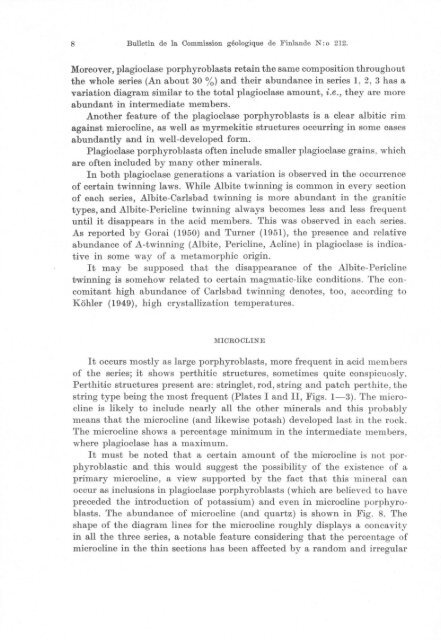COMMISSION GEOLOGIOUE - Arkisto.gsf.fi
COMMISSION GEOLOGIOUE - Arkisto.gsf.fi
COMMISSION GEOLOGIOUE - Arkisto.gsf.fi
You also want an ePaper? Increase the reach of your titles
YUMPU automatically turns print PDFs into web optimized ePapers that Google loves.
8 Bulletin de la Co=ission geologique de Finlande N: 0 212.<br />
Moreover, plagioclase porphyroblasts retain the same composition throughout<br />
the whole series (An abQut 30 %) and their abundance in series 1, 2, 3 has a<br />
variation diagram similar to the total plagioclase amount, i.e., they are more<br />
abundant in intermediate members.<br />
Another feature of the plagioclase porphyroblasts is a clear albitic rirn<br />
against microcline, as weil as myrmekitic structures occurring in some cases<br />
abundantly and in weil-developed form.<br />
Plagioclase porphyroblasts often include smaller plagioclase grains. which<br />
are often included by many other minerals.<br />
In both plagioclase generations a variation is observed in the occurrence<br />
of certain twinning laws. While Albite twinning is common in every section<br />
of each series, Albite-Carlsbad twinning is more abundant in the granitic<br />
types, and Albite-Pericline twinning always becomes less and less frequent<br />
until it disappears in the acid members. This was observed in each series.<br />
As reported by Gorai (1950) and Turner (1951), the presence and relative<br />
abundance of A-twinning (Albite, Pericline, Acline) in plagioclase is indicative<br />
in some way of a metamorphic origin.<br />
It may be supposed that the disappearance of the Albite-Pericline<br />
ttwinning is somehow related to certain magmatic-like conditions. The concomitant<br />
high abundance of Carlsbad twinning denotes, too, according to<br />
Köhler (1949), high crystallization temperatures.<br />
MICROCLINE<br />
It occurs mostly as large porphyroblasts, more frequent in acid members<br />
of the series; it shows perthitic structures, sometimes quite conspicuosly.<br />
Perthitic structures present are: stringlet, rod, string and patch perthite, the<br />
string type being the most frequent (Plates land H, Figs. 1-3). The microcline<br />
is likely to include nearly all the other minerals and this probably<br />
me ans that the microcline (and likewise potash) developed last in the rock.<br />
The microcline shows a percentage minimum in the intermediate members,<br />
where plagioclase has a maximum.<br />
It must be no ted that a certain amount of the microcline is not porphyroblastic<br />
and this would suggest the possibility of the existence of a<br />
primary microcline, a view supported by the fact that this mineral can<br />
occur as inclusions in plagioclase porphyroblasts (which are believed to have<br />
preceded the introduction of potassium) and even in microcline porphyroblasts.<br />
The abundance of microcline (and quartz) is shown in Fig. 8. The<br />
shape of the diagram lines for the microcline roughly displays a concavity<br />
in all the three series, a notable feature considering that the percentage of<br />
microcline in the thin sections has been affected by a random and irregular
















